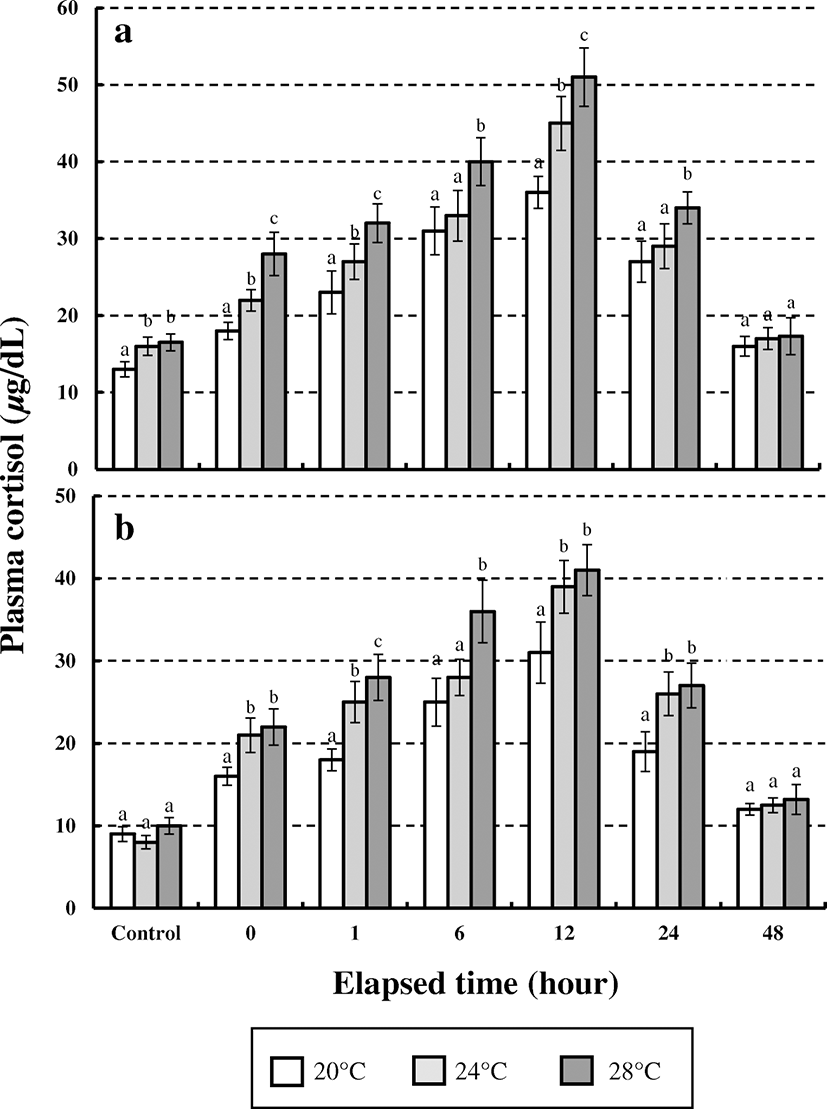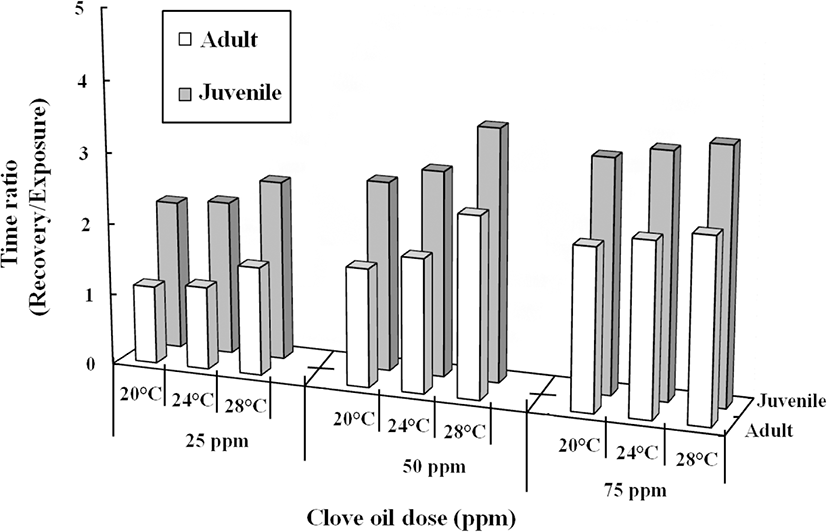Background
Anesthesia is generally used to attenuating stress caused by artificial handling, transportation, tagging, and injection because it lowers the metabolic rate due to sedative effect during the delicate handling period (Schreck 1982; Summerfelt and Smith 1990). Handling and transporting fish in a container and transport car is stressful to fish. They can lead to physiological stress, physical injury, and death (Marking and Meyer 1985). Therefore, many stress-relief methods have been attempted in the aquaculture society. Among different methods, anesthesia is found to be appropriate for handling fish. Effective anesthesia can alleviate plasma glucose and cortisol (Mommsen et al. 1999) and immobilize fish during manipulation. In addition, they are non-toxic to handlers. Moreover, it is simple to use. Despite the positive effects of anesthesia, inappropriate application of anesthetics may lead to unintended results. It might have adverse effects such as creating more stress, eliciting negative metabolic responses, and even leading to death. Therefore, determining the suitable concentrations of anesthetic is very important. Various responses of anesthetic effect have been specified previously (Summerfelt and Smith 1990), including anesthetic condition such as exposure time and recovery time. Many anesthetics have been used. Clove oil has been recently spotlighted as a useful fish anesthetic. Eugenol (4-allyl-2-methoxyphenol) is the active ingredient of clove oil. It is also non-toxic to handlers. Listed by the US Food and Drug Administration (1978), it has been experimented in fish at different stage including fry to adult fish. It is an excellent sedative anesthetic for long period transportation.
Red spotted grouper, Epinephelus akaara, is a species of fish in the order of Perciformes and Family of Serranidae (Brais 1987). Red spotted grouper is a reef fish. It inhabits in tropical and sub-tropical regions of Southeast Asia, especially in the China and Southern parts of Korea which have early life history. It is also registered as an endangered species (Brais 1987; IUCN 2016). This grouper fish is protogynous hermaphrodite. It can change sex from female to male (Brais 1987). Most studies have been limited to the only stages and conditions of this fish. This study focused on various temperatures, two stages (larvae and adult), and different doses/concentrations of clove oil. The main objective of this study was to provide anesthetic criteria of clove oil for an effective manipulation and transportation of red spotted grouper.
Materials and methods
Experiments were conducted at the Future Aquaculture Research Center in Jeju, South Korea. Ten juvenile specimens (standard length 9.1 ± 1.78 cm, body weight 14.3 ± 4.21 g; mean ± SD) and ten adult specimens (35.1 ± 5.92 cm, 1044.5 ± 149.63 g) were individually exposed to each anesthetic concentration. For sufficient adaptation, fish samples were acclimated for 1 week at different water temperature (20, 24, and 28 °C) with filtration and aeration. All fish samples were starved for 24 h prior to experiments. Water quality parameters during the experiment were tested daily and maintained as followed: pH 7.5 ± 0.07, salinity 31.2 ± 0.17, and dissolved oxygen 7.1 ± 0.35. Anesthetic used in this study was clove oil (82–87% eugenol, Sigma-Aldrich, St. Louis, MO, USA). Clove oil is poorly mixable with water. Therefore, it was dissolved in 95% ethanol (Sigma-Aldrich, St. Louis, MO, USA) at a ratio of 1:10. To determine the anesthetic dose, different concentrations of clove oil (25, 50, and 75 ppm) were exposed to fish at different water temperatures (20, 24, and 28 °C). Each juvenile fish was transferred from a stock tank to anesthetic-containing aquarium (20 L). Anesthetized sample was then transferred to a sea water tank containing (20 L with sufficiently aeration) for recovery. Individual adult fish was transferred to anesthetic-containing aquarium (100 L). Anesthetized individual sample was then transferred to a sea water tank containing (100 L) for recovery. Stages of anesthesia and recovery response are shown in Table 1. Exposure time (anesthesia time) and recovery time were recorded using a stopwatch. To define the stress response of experimental samples to anesthetic exposure, blood samples were obtained from ten randomly selected fish. In order to compare the blood plasma cortisol concentrations over time for 48 h at the same concentration (clove oil 50 ppm) of juvenile and adult fish, seven groups were established: control, no exposure to anesthetic; shortly after anesthesia: 1, 6, 12, 24, and 48 h. Blood was centrifuged at 200×g for 10 min and stored at − 80 °C freezer (Nihon Freezer, Japan) until analysis. Cortisol concentration in 50 μl samples was measured using a cortisol radioimmunoassay kit (Coat-A-Count TKCO Cortisol RIA Kit; DPC, USA). Two-way analysis of variance (ANOVA) and Duncan’s multiple range test (Duncan 1955) were used to determine the significance of difference among means of treatments using SPSS software (SPSS 9.0, SPSS Inc., USA).
*Modified from Summerfelt and Smith (1990)
Results and discussion
Different clove oil concentrations and temperatures affected the exposure time and recovery time for both juvenile and adult red spotted grouper. All experimental fish samples survived after being exposed to the anesthetic during the experiment. As shown in Table 2, exposure times of all samples were decreased when the concentration of clove oil was increased. Regarding the exposure time of juvenile and adult at 20 °C, juvenile samples were anesthetized 1.4–1.7 times faster than adult samples. At 24 °C, juvenile samples were anesthetized 1.3–1.6 times faster than adult samples. At 28 °C, juvenile samples were anesthetized 1.1–1.2 times faster than adult samples. When water temperature was further increased, the anesthesia time tended to be similar to each other between juvenile and adult.
*Each value is mean ± standard deviation of triplicate independent experiments (n = 10). Different small letters indicate significant differences for the different clove oil dose at the same water temperature (P < 0.05), the same superscript letter are not significantly different (P > 0.05)
Compared the water temperature in the anesthetic as temperature rose to 28 °C (20, 24, and 28 °C), a time of 1.2–1.3 times was decreased in all anesthetic concentration. When results were compared between low concentration and high concentration of clove oil, anesthesia time for both juvenile and adult samples at 75 ppm was shortened by more than 2 fold compared to that at 25 ppm, while results at 50 ppm were closer to those at 75 ppm than that those at 25 ppm. Recovery time for juvenile and adult showed the similar tendency at all anesthesia temperatures (20, 24, and 28 °C). When the concentration of clove oil was increased (25 to 75 ppm), the recovery time was shorter. Thus, the lowest concentration needed the longest anesthesia time and recovery time, while the highest concentration had the fastest anesthesia time and the recovery time. When the recovery time at different water temperatures was compared, juvenile samples took 1.1–1.3 times longer recovery time than adult samples at all temperatures.
According to Park et al. (2008) and Santos et al. (2015), fish samples are affected by both temperature and clove oil concentration. Santos et al. (2015) have determined the effect of different anesthetics (MS-222, 2-phenoxyethanol, clove oil, and benzocaine) on marbled rabbitfish, Siganus rivulatus, at different water temperatures. Marbled rabbitfish had the fastest anesthesia time at high temperature (30 °C) regardless of which anesthetic was used. Anesthesia time at high temperature and concentrations attributed to exposure time and recovery time of kelp grouper, E. bruneus, which showed different tendency of recovery time compared to red spotted grouper. In general, high anesthetic concentration requires a longer recovery time (Simoes et al. 2011; Tarkhani et al. 2016). For Nile tilapia (Oreochromis niloticus), after exposing to various concentrations (50 to 100 ppm) of clove oil, recovery time from high concentration exposure is more than two times longer compared that from low concentration exposure (Simoes et al. 2011 Tarkhani et al. (2016) have found that, as the weight of flowerhorn, Amphilophus labiatus × Amphilophus trimaculatus is increased (12 to 53 g), eugenol concentration needed for anesthesia is increased (25 to 200 ppm). Ghanawi et al. (2013) have studied spinefoot; Siganus rivulatus were experimented at anesthetized at clove oil (40, 70 and 100 ppm), they were recorded similar tendency to red spotted grouper. Therefore, when water temperature or the concentration of clove oil is changed, the anesthesia time and recovery time might be different.
Regarding the stress responses based on plasma cortisol of time after being exposed to clove oil, results of plasma cortisol concentrations in red spotted grouper with elapsed time are shown in Fig. 1. Plasma cortisol concentrations at each temperature was increased as time elapsed, reaching the peak level at 12 h after exposure to clove oil. They were then decreased from 12 to 48 h after exposure to clove oil in both juvenile and adult samples. They were then recovered until 48 h. Plasma cortisol concentrations at high water temperatures (24 and 28 °C) were slightly but significantly (P < 0.05) higher than those at low water temperature (20 °C) in all samples.

Plasma cortisol can be an indicator of stress response in fish subjected to various harsh environment. It is related to metabolism and movement (Mommsen et al. 1999). Plasma cortisol level can be influenced by handling, air exposure, and sampling. Thus, determining cortisol concentrations is very important. Park et al. (2008) have reported that, when kelp grouper are exposed to clove oil, plasma cortisol is increased until 12 h and decreased thereafter. Figure 2 can be used to understand the relationship between exposure time and recovery time. Figure 2 was modeled by a division of exposure time to recovery time. It can be used to determine the effects of different temperatures, anesthetic concentrations, and fish stages on exposure time and recovery time. As shown in Fig. 2, juvenile and adult had the similar ratio of exposure time to recovery time at each temperature. The time ratio at 28 °C was slightly larger than that at other temperatures at 25 or 50 ppm. Overall, juvenile samples had larger time ratio than adult samples at all temperatures and concentrations. Based on the time ratio reported by Park et al. (2008), kelp grouper showed a smaller value than red spotted grouper, suggesting that red spotted grouper might be more sensitive to clove oil anesthesia than kelp grouper.

Suitable anesthetic concentrations have been used to measuring the exposure time within 3 min and recovery time within 10 min (Park et al. 2003). Clove oil concentrations of that experiment did not cause injury or death. They were harmless to handler and fish samples. In this study, we used the effect of different water temperatures on anesthesia time and recovery time in juvenile and adult red spotted grouper. However, effects of salinity variations and different anesthetics on red spotted grouper are also important. Such studies should be performed in the future. Nonetheless, our results may provide useful information for performing successful anesthetic experiment using red spotted grouper.
Conclusions
The effect of clove oil as an anesthetic plays a sufficient role in the red spotted grouper, Epinephelus akaara. As the water temperature and concentration increased, both the anesthetic time reduced and the recovery time increased. Plasma cortisol, which was measured to examine the stress response, was increased up to 12 h after anesthesia but decreased thereafter, which was almost the similar as that of the control group at 48 h.








